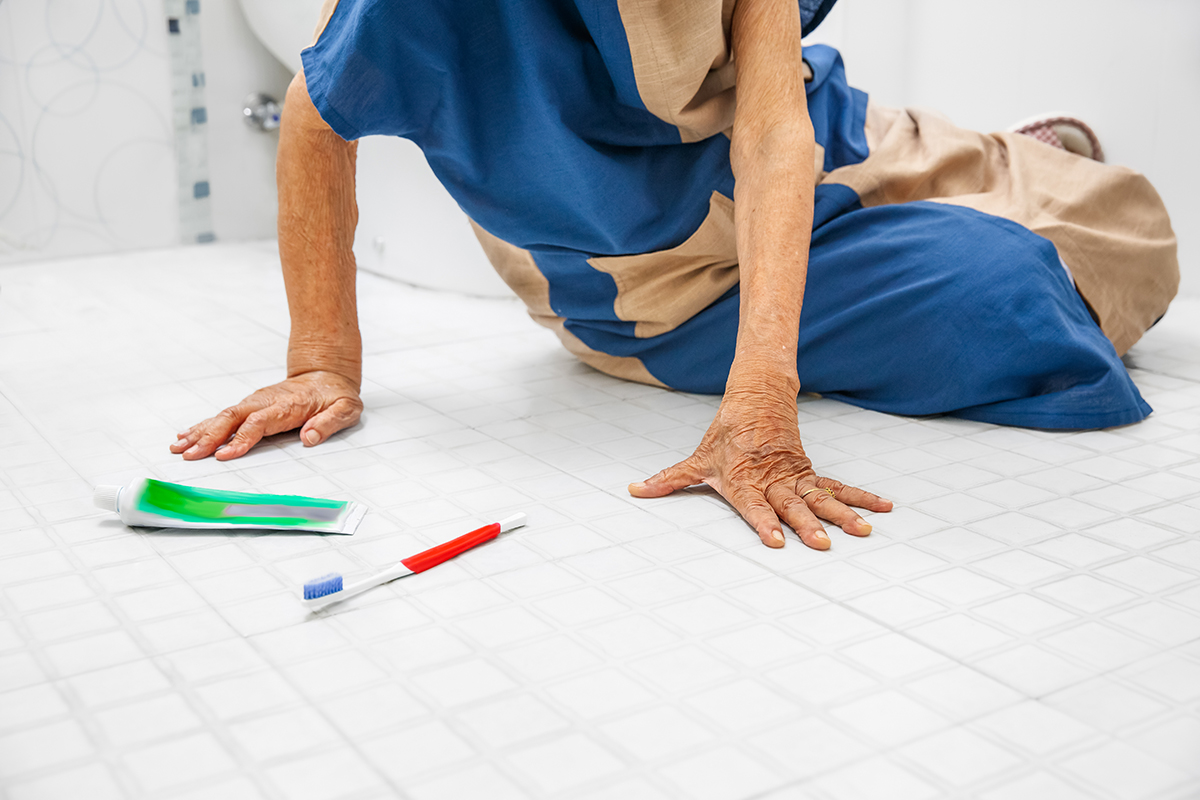Falling is an issue for almost every chronic condition discussed in this text, from peripheral neuropathy to CVA’s, as well as sarcopenia that leads to fragility. Things like poor hearing, dizziness, joint stiffness or even wearing glasses can also disrupt a person’s balance. Some medications such as blood pressure, sleep medications and antidepressants may influence balance. A bad fall can make a chronic condition even more disabling. The consequences of a fall include serious injury, limited activity and significant medical costs. Many older people never fully recover from a fall.

Guarding Against Falls
If they are going to fall, most people (particularly stroke victims) will fall toward their weak side. They can also fall forward or backward. They fall primarily because their muscles are weak and their legs crumple under them or because their balance is poor. The American Geriatrics Society suggests fall screening be done at each annual doctor’s visit. Tell your client to mention to the doctor if they are having a balance problem or have fallen within past 12 months.
Safety Tip
If the person’s left side is weaker, stand at the person’s left side and just a little behind. Put your right hand on their belt or transfer / gait training belt and your left hand on the front of their shoulder. In this position you can push back on their shoulder and push forward on their hips to straighten them up, or you can pull them against yourself. In case you cannot hold the person up, you are in a good position to ease them gently to the floor if they should start to fall. Remember to use good body mechanics. If a person is falling, you can do more harm to your back and to them by straining to hold them up than if you ease them to the floor. You should never hold a person only by the arm or let them hold onto you, because if they suddenly start to fall, you will both fall over.
Tip: Transfer belts are available at most drug stores.
Preventing Falls
Keeping the walkways well lite is a good precaution. Nightlights on. To make house safer consider the following top 10 safety checklist items:
- Don’t let person rush to phone or door.
- Discourage them from wearing long bathrobes or slippers that can be a tripping hazardous.
- Teach person to get up slowly from sitting or lying, to avoid postural hypotension, (Low Blood Pressure).
- Teach them to transfer safely from place to place.
- Make sure person knows how to use cane or walker properly
- Remove all tripping hazards, extension cords, books, throw rugs. If the people have pets make sure toys are out of way and cats should wear a bell.
- Keep things within reach, to avoid step stool use.
- Have grab bars installed where needed.
- Use non-slip mats where needed.
- Teach them to be alert to outside hazards, wet sidewalks etc.
Reprinted with permission from Karl Knopf
Karl Knopf, Ed.D, served as the Director of The Fitness Therapy Program at Foothill College for almost 40 years. He has worked in almost every aspect of the industry from personal trainer and therapist to consultant to major Universities such as Stanford, Univ. of North Carolina, and the Univ. of California well as the State of California and numerous professional organizations. Dr. Knopf was the President and Founder of Fitness Educators Of Older Adults for 15 years. Currently, he is the director of ISSA’s Fitness Therapy and Senior Fitness Programs and writer. Dr. Knopf has authored numerous articles, and written more than 17 books including topics on Water Exercise, Weights for 50 Plus to Fitness Therapy.
References
- Focus on Healthy Aging publication, 2016
- ISSA Fitness Therapy Course, 2019
- WebMD – focus on falls, March, 2019
- IDEA Journal, Effective Posture, February 2015
- American College of Sports Medicine, “physical activity falls and physical function, ,July, 2019
- Weights for 50 plus, Knopf Ulysses Press, 2006
- Resistance Band Workbook, Knopf, Ulysses Press, 2013
- Stability workouts on a Balance Board, Knopf, Ulysses Press, 2017 Core Strength for 50 plus, Knopf, Ulysses Press, 2012
